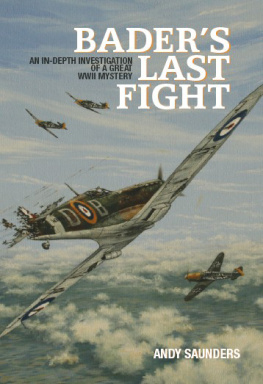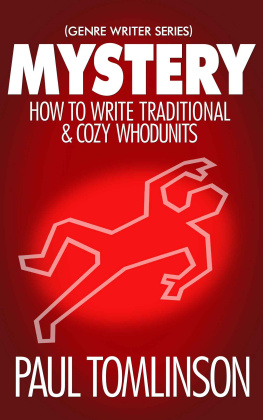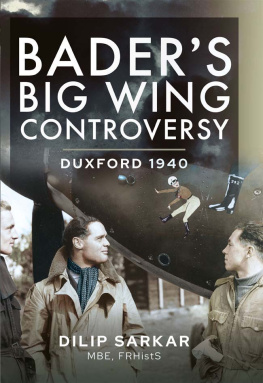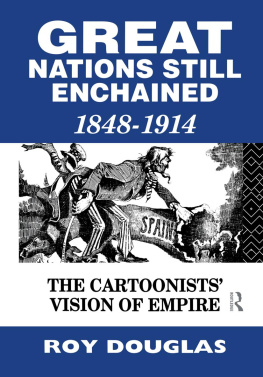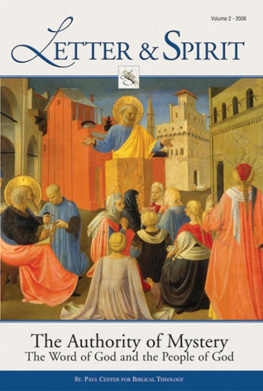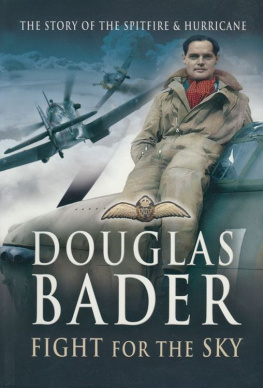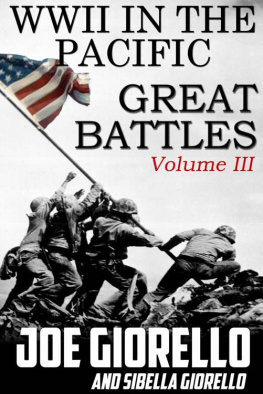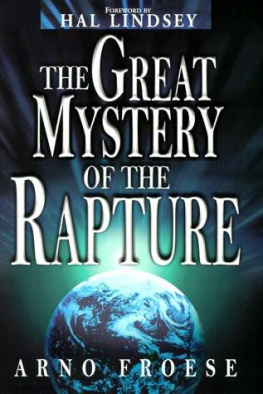Published by
Grub Street
4 Rainham Close
London
SW11 6SS
Copyright 2007 Grub Street, London
Text copyright 2007 Andy Saunders
British Library Cataloguing in Publication Data
Saunders, Andy
Bader's last fight : an in-depth investigation of a great
WWII mystery
1. Bader, Douglas, 1910-1982. World War, 1939-1945 Aerial
operations, British 3. World War, 1939-1945 Aerial
operations, German 4. Friendly fire (Military science)
I. Title
940.5'44941'092
ISBN: 978 1 904943 96 9
EPUB ISBN: 9781909166745
All rights reserved. No part of this publication may be reproduced,
stored in a retrieval system, or transmitted in any form or by any
means, electronic, mechanical, photocopying, recording, or
otherwise, without the prior permission of the copyright owner.
Cover design by Lizzie B design
Book design and formatting by:
Roy Platten, Eclipse
Printed and bound by MPG Ltd, Bodmin, Cornwall
Grub Street only uses
FSC (Forest Stewardship Council) paper for its books.
For my son, Steven James Saunders
And dedicated to the memory of
Sergeant Pilot G C B Chapman 404198
452 Squadron RAAF
Age 28
Killed in Action
Circus 68
9 August 1941
A UTHOR S N OTE
The views expressed in this work are those of the author alone, unless otherwise attributed. No criticism of any person (living or dead) is either intended or implied.
C ONTENTS
A CKNOWLEDGEMENTS
A great many friends, colleagues, fellow researchers and others I have met along the path of this project have provided input and assistance with my preparation of this book. Without them my task would have been immeasurably harder. In no particular order of merit I would like to extend my humble thanks to the following:
Winston Ramsey, Norman Franks, Chris Goss, John Foreman, Ruth Bloom, Wing Commander B M E Bernie Forward OBE RAF(Rtd), Julius Heger, Simon Raikes, Natalia Dannenberg, Dr Alfred Price, Jessica Cobb, Philip Clark, Jim Allen, Paul Cole, Peter Cornwell, Peter Dimond, David Norman, Simon Parry, Philippa Wheeler, Gareth Jones, Tim Davies, Richard Barnstable, Vince Megicks, Flight Lieutenant Mary Hudson, Georges Goblet, Captain Doug Newman (Canadian Armed Forces), Kim Hemmingway, Liz Watts, Ron Scott, Graham Warner, Eddie Taylor, Andr Clerbout, John Crossland, Flight Lieutenant Keith Lawrence DFC, Donald Caldwell, Jean-Pierre Duriez, John Davies, Hannah Stuart, Tony Holmes, Alma Bostock, Dr Fiona Gabbert, Jack Misseldine, Andy Barton, Jim Underwood, Keith Dowle, Ray Brebner, Aldon P Ferguson and Steve Brew.
A special thank you is due to my old friend Peter Arnold for his advice on all matters relating to Spitfires and his valuable contribution to this work.
For his assistance on matters relating to the Polish participation during Circus 68 I must thank Wojtek Matusiak not least of all for ensuring the correct spelling of Polish names!
I must also thank the late General Adolf Galland, Jeff West, Bob Morton and Gerhard Schoepfel.
I would also like to give special thanks to the Battle of Britain pilot Squadron Leader Peter Brown, AFC, who spent a good few hours and over a long period of time talking to me about various technical, tactical, strategic and historical issues. Peter, you certainly helped me get a number of things clearer in my head and were a willing pair of ears when it came to talking the various issues through.
Last, but by no means least, I am indebted to the late Squadron Leader L H Buck Casson DFC. Without his candour, without his contact with me over many years and without his account to me of events during that fateful day this book would never have been written. RIP, Blue One.
If I have unintentionally forgotten or omitted anyone then I offer my unreserved apologies.
I NTRODUCTION
Douglas Bader was a legendary if not iconic figure of World War Two. Views about Bader the man, the fighter leader and Bader the pilot have always been polarised and, to an extent, he has been a controversial figure both during and since the war and, not least of all, through his involvement in the Big Wing episode in the history of RAF Fighter Command. This, though, is not a biographical study of the man himself but the examination of an event for which he is arguably most famous being brought down and taken prisoner of war over France during August 1941. It is a story which has been famously told in his biography Reach for the Sky, and in the film of the same name where his part was portrayed by Kenneth More.
There can surely be few who are not already familiar with the dramatic story of his apparent mid-air collision with a Messerschmitt 109 and his desperate life or death struggle to escape by parachute as one of his artificial legs became trapped in the cockpit of his Spitfire. For decades this has been accepted as an accurate version of events that day and it is only in recent years that a question mark has been placed over what really happened. This book, then, is a thorough examination of events that day and the contents may be considered by some to be controversial in that the widely accepted official version of events is questioned, challenged and refuted. The author, though, does not seek to be revisionist. Instead, it is the intention to present the known and verifiable facts along with more recently discovered details of what took place that day. In addition, to offer up some hard physical evidence and proffer an alternative interpretation as to what transpired in the skies above northern France during Baders last fight. Notwithstanding the fact that this is not a Bader biography it would, nonetheless, be remiss not to paint a brief thumbnail sketch of Bader the man before moving on with this extraordinary account.
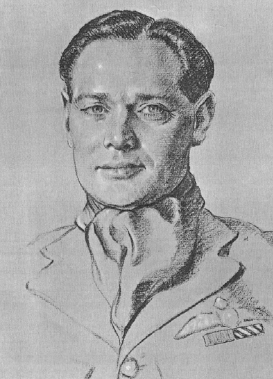
Portrait of Squadron Leader D R S Bader DSO, DFC, by Cuthbert Orde.
Douglas Robert Steuart Bader was born in St Johns Wood, London, on 21 February 1910, the second son of Jessie and Frederick Bader. Shortly after his birth the family relocated to India where Frederick worked as a civil engineer, although it was not long before the young Douglas was returned to the United Kingdom to be looked after by relatives on the Isle of Man. It was not until he was almost two years old that Douglas rejoined the family although, by 1913, they had returned for good to England. Upon the outbreak of war Frederick accepted a commission in the Royal Engineers and served with them in France, being severely wounded in the head during 1917.
Separation from his father thus became a feature of the young Douglass life, and this was compounded by his later admission to private boarding schools first at Eastbourne and then at Oxford. From here he won a prize cadetship to the RAF College at Cranwell in 1928, where, in 1930, he was commissioned and posted to 23 Squadron at Kenley, then flying Gamecocks, and eventually to fly at the Hendon Air Display in 1931 as an aerobatic competition pilot. The following year, on 14 December, and still with 23 Squadron, he crashed at Woodley aerodrome after unauthorised aerobatics in a Bristol Bulldog and was seriously injured. As a result, he lost both legs; the right one above the knee and the left below.
Bader was invalided out of the service on 30 April 1933, unfit for flying duties, and obtained employment with the Asiatic Petroleum Company (later Shell) although, prior to the outbreak of war, he had agitated to return to active flying and was finally accepted after a test at the Central Flying School, Upavon, on 18 October 1939. With the rank of flying officer, and after a brief refresher course, he was posted on 7 February 1940 to 19 Squadron at Duxford, flying Spitfires, and then on to 222 Squadron, also at Duxford and also with Spitfires, as flight commander during March.
Next page
